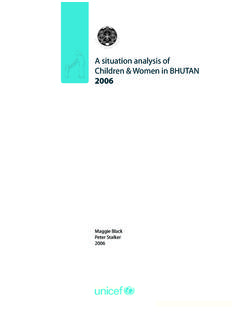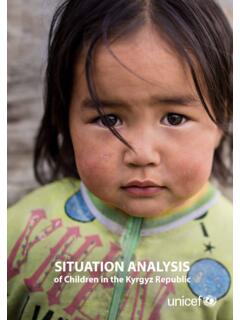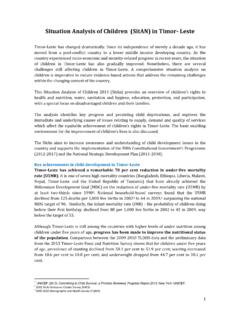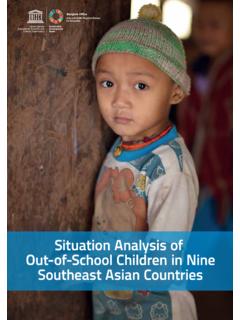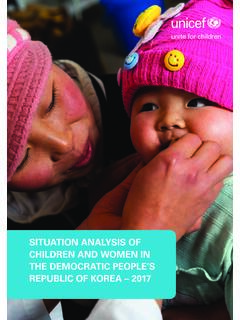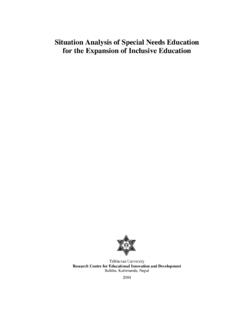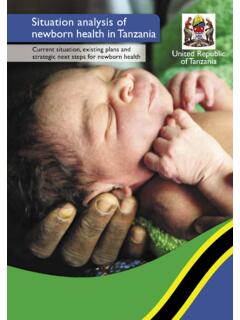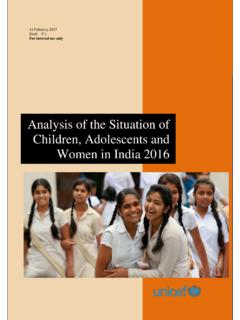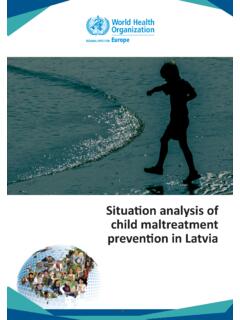Transcription of Disability in BangladeshRev - World Bank
1 Disability IN BANGLADESH A situation analysis Final Report May 2004 The Danish Bilharziasis Laboratory for the World Bank People s Republic of Bangladesh Disability in Bangladesh: A situation analysis The Danish Bilharziasis Laboratory for the World Bank, People s Republic of Bangladesh _____ 2 EXECUTIVE SUMMARY 1. Objectives Since several overarching strategic documents are underway in Bangladesh including the Poverty Reduction Strategy Paper (PRSP), several sector-programmes and thematic national action plans, it has been found timely to assess the situation and needs in relation to Disability . The objectives of the present analysis are as follows: (I) To assess the current prevalence, severity and causes of Disability as a physical and social phenomenon, with a particular focus on children with disabilities.
2 (II) To map and assess the scope of the current situation and initiatives in the public sector, the private sector, among Non-Governmental Organisations (NGOs) and in communities as well as the linkages between initiatives. (III) To offer short and longer term recommendations for further research, policy development and support for interventions in relevant sectors (health, education, labour etc). 2. Disability and Poverty Poverty creates Disability and Disability creates poverty. People with disabilities are often among the poorest of the poor. The World Bank estimates that disabled people make up to 15-20% of the poor in developing countries.
3 In Bangladesh most people with disabilities live in the rural areas. They, and sometimes also their families, are often excluded both from their communities and from development initiatives. The most vulnerable are women and children with disabilities. 3. Data on Disability The number of people with disabilities in Bangladesh is high enough to merit special attention. Based on an assessment of the available figures and estimates by WHO and World Bank for developing countries, an overall Disability prevalence of about 10% of the population remains a valid working estimate. The prevalence of disabilities in children below 18 years can be estimated to 6% and for the age group above 18 years the prevalence to about 14% or corresponding to million children with disabilities and million adults with disabilities.
4 The team recommends that Disability dimensions are integrated in planned and future surveys for monitoring progress through equity, service delivery and outcome indicators. At the same time the establishment of a routine Disability management information system could be initiated with the newly established District Disability Welfare Committees as the focal point. 4. Policy context The United Nations Economic and Social Commission for the Asia and Pacific (UNESCAP) Biwako Millennium Framework from 2003 sets out a regional policy framework, which is coupled with a Bangladesh National Disability Welfare Act from 2001. An Inter-ministerial Task Force has developed a National Action Plan, which is currently being reviewed in 18 Ministries.
5 District Disability Welfare Committees have been established in most districts and nine have developed District Action Plans. The team recommends that the National Action Plan is made further operational and supported with a focus on implementation at community and district levels. 5. Stakeholders and coordination There is currently a momentum for action at national level. The Ministry of Social Welfare holds the formal responsibility for Disability and there is potential for more cross-sectoral Disability in Bangladesh: A situation analysis The Danish Bilharziasis Laboratory for the World Bank, People s Republic of Bangladesh _____ 3work through the National Coordination Committee and the Inter-ministerial Task Force.
6 The National Forum of Organizations Working with the Disabled (NFOWD) is an umbrella organization for more than 150 Disabled Peoples Organizations (DPOs), NGOs and International NGOs (INGOs) working in the field of Disability , constituting an active, extensive and capable network. International agencies and donors are interested in supporting Disability activities, but sometimes face problems in channeling funding for cross-sectoral issues, such as Disability . Common for all these stakeholders are an interest in working with Disability , but so far each of them with a very limited coverage concentrated in urban and selected rural areas and a fundamental lack of coordination.
7 The team recommends that coordination is strengthened through the National Coordination Committee/Inter-ministerial Task Force and that work is given direction through a more action-oriented version of the National Action Plan. 6. Sectoral involvement Disability is a cross-sectoral issue. The team has assessed the situation and activities of Government, NGOs/INGOs and the private sector, and suggested next steps for inclusion and reduction of vulnerability by sector: Social Welfare: Focus on rehabilitation and inclusion activities at district level Education: Support the process of inclusion into regular schools Health: Scale up Early Detection Programmes and establish referral networks Employment and Income Generating Activities: Actively stimulate inclusion Transport, Infrastructure and Built Environment: Mainstream accessibility Access to Water and Sanitation.
8 Support and mainstream pilot projects Increased coordination at both national and district level will be crucial to fully take advantage of the considerable expertise and materials already available in Bangladesh. In order to sustain and expand technical expertise and leadership in Government as well as in DPOs/NGOs, it is necessary to review and invest in the development of human resources. At all stages in the process people with disabilities, represented by DPOs and NGOS active in the Disability field, should be included in decision making processes. Disability in Bangladesh: A situation analysis The Danish Bilharziasis Laboratory for the World Bank, People s Republic of Bangladesh _____ 4 PREFACE This situation analysis is the result of an initiative by the Health Program Support Office of the World Bank in Dhaka, to map out Disability in Bangladesh.
9 This final report is intended to provide input into a number of strategic plans, such as the Poverty Reduction Strategy Paper (PRSP) and sector-programs which are under preparation in 2004, and to identify existing initiatives that could be scaled up in this regard. The consultancy was carried out in February-April 2004, and included an 18-day mission in Bangladesh by a Danish-Bangladeshi team consisting of Dr. Jens Byskov (team leader), Mr. Khandaker Jahurul Alam, Mr. Nazmul Bari and Ms. Birgitte Bruun. Resource persons in Denmark were Dr. Hans Wulffsberg, The Danish Council of Organizations of Disabled People (De Samvirkende Invalideorganisationer DSI), and Dr.
10 Jens Aagaard Hansen, Danish Bilharziasis Laboratory. The findings and recommendations in this report are a result of data collection and discussions with a range of stakeholders in Bangladesh and remains the responsibility of the consultancy team and the Danish Bilharziasis Laboratory. ACKNOWLEDGEMENTS It has been a guiding principle for the consultancy team to make the consultancy process as participatory as possible. Thus, the desk review and the draft final report have both been circulated widely in Bangladesh for all stakeholders to comment on the contents. The team is very grateful for the enthusiasm, time and support extended from all stakeholders before, during and after the mission in Bangladesh.










